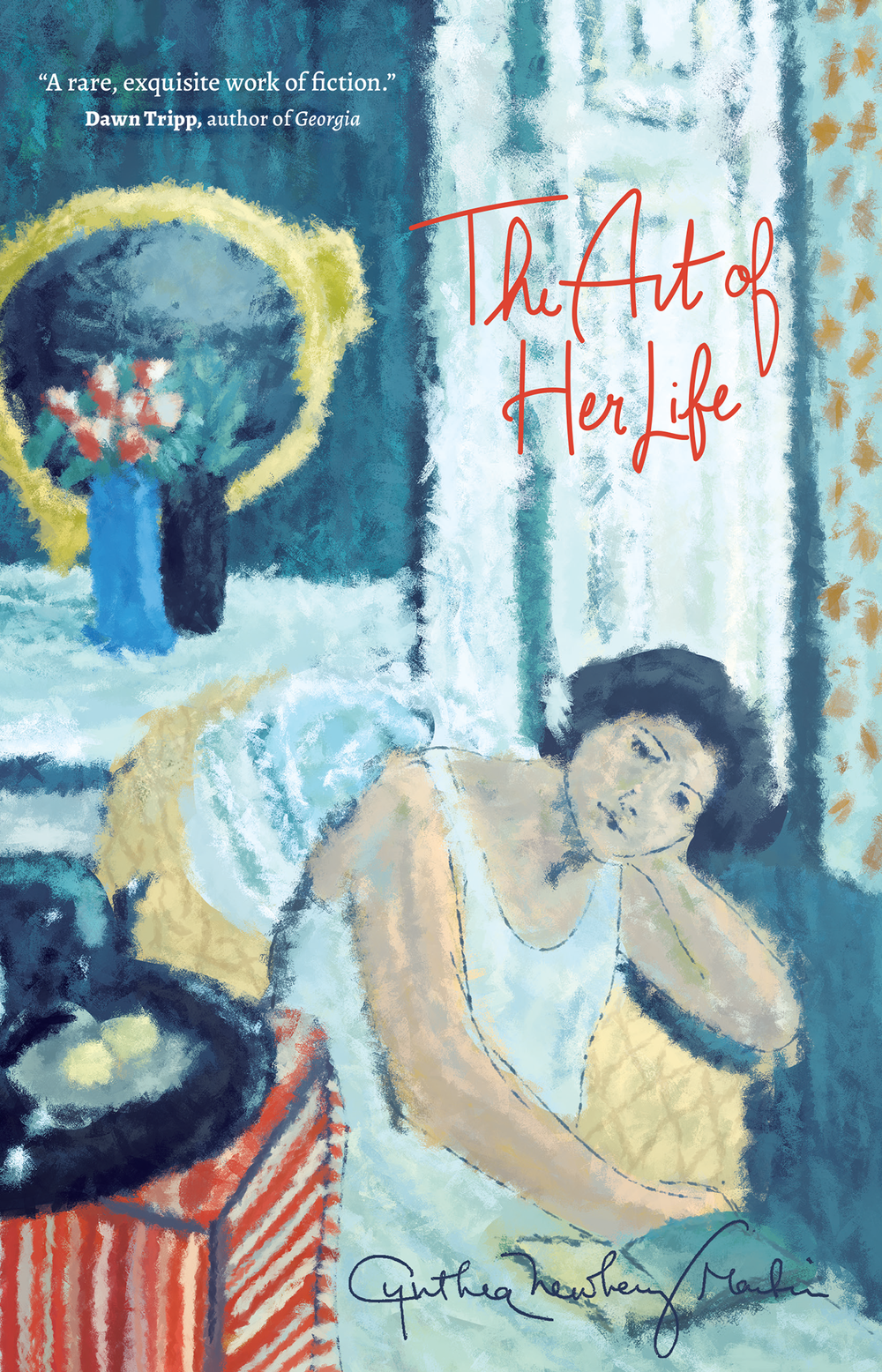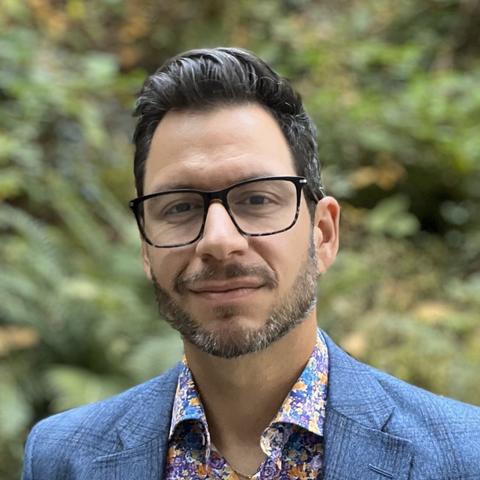
Section Branding
Header Content
The Art of Her Life by Cynthia Newberry Martin
Primary Content
At nine years old, on her first visit to a museum, Emily fell in love with Breakfast, a painting by Henri Matisse. Now a single mother, she lives in the world of art and can barely find time for her two daughters, much less for Mark, the man she loves. Her days are a jumble—she’s lost the thread of her life—but a contest at the museum where she’s the registrar gives her hope. The Art of Her Life shows the power of art to transform an ordinary life.

TRANSCRIPT:
NarrativeEdge_ep39_v1.mp3
Peter Biello: Coming up in this episode.
Orlando Montoya: This book is a very interesting and amazing blend of art and Emily's story.
Cynthia Newberry Martin: She is under anesthesia. She's in the hospital. She's confusing reality with Dream, and I wanted the narration to reflect that.
Peter Biello: I spent four months in France in college and wasn't really into the art. I guess the Francophilia that infected me was more the wine.
Orlando Montoya: The wine and cheese and the baguettes.
Peter Biello: This podcast from Georgia Public Broadcasting highlights books with Georgia Connections hosted by two of your favorite public radio book nerds, who also happen to be your hosts of All Things Considered on GPB Radio. I'm Peter Biello.
Orlando Montoya: And I'm Orlando Montoya. Thanks for joining us as we introduce you to authors, their writings and the insights behind their stories mixed with our own thoughts and ideas on just what gives these works for Narrative Edge.
Peter Biello: Okay. Orlando, You asked me to prepare for today's episode by asking me to think about a favorite painter or a favorite painting. Why?
Orlando Montoya: Because the book we're going to be talking about today revolves around art. It's a work of art in words called The Art of Her Life, by Cynthia Newbery Martin from Columbus, Georgia. It is a work of fiction, but a central figure in this book is really honoring Matisse. Matisse, the French. I thought he was an impressionist, but apparently he was for a little while. Then he had other styles and I learned a lot about Matisse from this book. He lived a very long time from 1869 to 1954.
Peter Biello: Okay, So the book is fiction. It's called The Art of Her Life. Titled doesn't refer to Matisse. So who is the she in the title?
Orlando Montoya: The she in the title refers to the main character of this book, Emily. She is obsessed with Henri Matisse. She is a 36 year old curatorial assistant at an art museum in Charleston, South Carolina. And over the course of six sections. We don't have chapters in this book. We have really long sections. But over the course of this book, we follow Emily in some really difficult periods in her life, and we get through them with art and we understand them with art, specifically Henri Matisse. This book is a very interesting and amazing blend of art and Emily's story.
Peter Biello: All right. So tell me a little more about Emily's story. And I'm curious about what was going on in her life and what drew her to Matisse. So she works she works in an art museum, really likes Matisse. What's she going through?
Orlando Montoya: All right. So very early in the story, we're introduced to the two main, I guess you would say, plot drivers of the story. There is her relationship with her boyfriend, Mark. It's falling apart. They're not getting along. They have different priorities in their lives. And the second sort of plot device is her health. She has a cancer scare. The tests, they can't tell it's too early for a diagnosis. Does she or does she not have cancer? And in the midst of this, she's raising two daughters from a previous relationship. She's trying to advance her career at the museum and she doesn't know what to do. And this section of the book is named after the Henri Matisse painting called Breakfast.
Cynthia Newberry Martin: What is cool about this painting and I didn't even learn this until I was well into writing the book is that Matisse painted this in 1920 in Nice, and it's typical of that time period in his painting life for a number of reasons. The brushstrokes, the the colors, the bright, mainly the bright colors and the brushstrokes and the patterns that you see in the painting are typical of that time. But what is unusual about Breakfast is that it creates a sense of intimacy and it focuses on the psychological feeling of the of the model.
Orlando Montoya: And one thing I love about this book is that the sections are named after different Matisse paintings, so you can follow along with the story in the paintings. Now, there are no images in the book. Breakfast is on the cover, but you'll have to sort of look up the other paintings for yourself. And I am going to show you Breakfast.
Peter Biello: Okay.
Orlando Montoya: Breakfast there by Henri Matisse.
Peter Biello: Okay. Looking at Breakfast, there's a woman in a chair sort of leaning away from her breakfast. It's got le teakettle on the table. What looks like a bowl of lemons. Are those lemons on there? And then she's got flowers in the background. So there are the bright colors that you were talking about. So, yeah, I mean, how does this fit into the story? And more importantly, do you think that, like, you need to know the paintings that that.
Orlando Montoya: No, definitely not.
Peter Biello: You don't need to have studied art history and know you know what's going on.
Orlando Montoya: You don't even have to look up the paintings if you don't want to.
Peter Biello: Okay.
Orlando Montoya: It is interesting. And that's what interested me about the book. I'm like, how is this story going to relate to these paintings?
Peter Biello: So if you know the paintings, does it add a layer, kind of like an Easter egg for the book?
Orlando Montoya: I think so. It's yeah, it's sort of an extra bonus, I think. Okay. But, you know, I asked the author, what does this painting mean with this part of the story? And Cynthia Newbery Martin wouldn't tell me. She wanted to leave that up to me and the readers. She said there were two interpretations of Breakfast. And believe me, last night I Googled, you know, what are the two interpretation of Henri Matisse Breakfast? But I didn't get anything. So the way I interpret it is that the woman in the painting is bored. She's lost in thought. She's expecting something. She's contemplating something
Peter Biello: We're already way farther than two at that point. More than more. More than two interpretations.
Orlando Montoya: That's what I'm guessing. She is just sort of bored and contemplating something. And that's what Emily is in this section of the book. She's bored with her job. Or more precisely, the people she works with. She's lost in thoughts about her health. She's expecting word about her health and she's contemplating what to do about Mark. Does she want Mark or not? And so that's how this painting fits in with the story, in my opinion.
Peter Biello: Can I ask you to back up and tell me what the relationship problem is between these two? You said they have different priorities.
Orlando Montoya: So Mark wants to get married and Emily basically does not want to get married. And so Mark wants to move on with his life or get married. That's that's the big problem there. They they argue about other things, too, but that's the big problem.
Peter Biello: Okay. Well, was Cynthia Newberry Martin a big fan of Henri Matisse when she started writing this book?
Orlando Montoya: She told me she was not sure that she doesn't even have an art background. She says she was a Francophile. And Francophilia has a way of getting to Henri Matisse.
Peter Biello: Okay. Yeah, I could see that. I mean, I spent four months in France in college and wasn't really into the art. I got the Francophilia that infected me was more the wine
Orlando Montoya: The wine and cheese and the baguettes. But the choice of this particular artist for the book's inspiration had not to do with her love of Matisse or really art, but it was really with that one painting Breakfast.
Cynthia Newberry Martin: It was more about choosing a painting that could be interpreted at least two ways. And it was back in the early 90s when I started writing this book, so I had lots of coffee table books from museum visits and exhibits, and I just started looking through those to find a painting that I could interpret in two ways.
Peter Biello: Wow. She's been writing this since the 90s.
Orlando Montoya: Yeah. So she's I guess it's. It's a slow burn.
Peter Biello: Yeah. She must have a day job of some kind keeping her from this.
Orlando Montoya: I don't know. I didn't ask.
Peter Biello: Didn't ask. Okay. All right, so where does the story go from Breakfast? Emily is deciding whether or not to keep or ditch her boyfriend. And she doesn't know if she has cancer. So a couple of heavy things there. What's next?
Orlando Montoya: Well, the next section of the book is named after the Henri Matisse painting called The Invalid.
Peter Biello: Ooh. Okay. So the cancer.
Orlando Montoya: The cancer. Yes. I don't think it's giving too much of the story away to reveal her diagnosis. By the way, I mean, she spends the first quarter of the book talking about cancer, so there's not much you can do after talking about cancer that much in the first quarter.
Peter Biello: Other than to get it.
Orlando Montoya: Other than to get it.
Peter Biello: What kind of cancer is it?
Orlando Montoya: Ovarian. So, yes, she has cancer. She lets Mark leave. Mark is an archeologist. He goes to Turkey to work on sunken ships and ancient buried towns. But she's going through these horrible treatments. You know, she has friends that help her. Yes. She continues taking care of her daughters, but she's in really, really bad shape. And her narration and I should say this is a first person narration. So Emily is telling the story. Emily's narration in this part becomes very disconnected, very poetic, very dreamlike. It's all light and shadow and it happens gradually. And you really can't tell what's happening sometimes, but it's very beautiful. I really love this part of the story. Again, the section is called The Invalid.
Cynthia Newberry Martin: This is one of Matisse's earlier paintings, but it perfectly this was the most perfect match of all the paintings to the parts. And this was painted earlier in Matisse's career, right? Maybe 1899, if I'm remembering. Right. Emily. She is under anesthesia. She's in the hospital. She's confusing reality with dream. And I wanted the and, you know, she's awake. She's asleep. She's awake. People are coming in. And I wanted the narration to reflect that.
Peter Biello: Wow. So does Emily wake up from this dream?
Orlando Montoya: I will say that The Invalid is not the last chapter.
Peter Biello: Okay, so that's a clue. Okay.
Orlando Montoya: And I will say that in the final sections, she needs someone.
Peter Biello: Okay. And is that someone, Mark?
Orlando Montoya: Actually, the person she needs most of all is Henri Matisse.
Peter Biello: Okay. How did I know that was coming?
Orlando Montoya: Emily needs Matisse. Really. She does like air and water. Throughout the book, we get little nuggets about Henri Matisse through his own writings. Emily talks about this because, as I mentioned, she loves Matisse. She relates her life to his and she often quotes from Matisse's own words as relayed through a 1973 book called Matisse on Art by a writer named Jack Flam.
Cynthia Newberry Martin: Jack Flam collected all of Matisse's writings, his essays, his statements, his interviews, anything he could get his hands on there about 50 some odd text in this book, and he translated them from the French into English. And it's a magical compilation of of Matisse on Art. And anyone who loves art or loves being an artist, I would highly recommend this book. It's it's wide open. It's not just about painting. It's about everything that made Matisse, Matisse. And so if if I was falling in love with in love with it, without an art background, Emily was sure to fall in love with it.
Orlando Montoya: So it's sort of a book within a book. And I have to say, I really love these nuggets about life and living and art relayed through Jack Flam relayed through Emily.
Peter Biello: Were you tempted to read the Jack Flam book?
Orlando Montoya: I was. But, you know, you and I have like news to do every day.
Peter Biello: Yes. We have things going on.
Orlando Montoya: Other books to read. But I might in the future because the little nuggets that I get from it in this book kind of reminded me of a transformational book in my life. And that was called Letters to a Young Poet by Rainer Maria Rilke, which has sort of the same vibe of offering life advice through the lens of art. And any time I can mention Rilke's book, I will.
Peter Biello: That used to be real popular in Europe in the 20th century, right? Writing long philosophical things about your art. I think in being the Francophile that I used to be, right? I used to be called the not poetic, right? Am I getting that right? And I remember in college correctly,.
Orlando Montoya: It sounds philosophical.
Peter Biello: Yeah, like the painters. Like it seems like what Matisse did it was pretty common. They write a statement about what guides their art, and it would often be biographical, philosophical, that kind of thing.
Orlando Montoya: Yeah. I realize. I suggest all of these things. Rilke, Matisse and going to your art museum and looking at your favorite paintings. Speaking of which, I did ask, What is your favorite painting or painter?
Peter Biello: Almost ashamed to admit this because it reveals a lot about how lowbrow I am, which is Mark Ryden. Have you heard of Mark Ryden? First of all, I should say I am not like scouring the universe for paintings that I might like. It's not typically the art form that I gravitate to when I want to appreciate something. That's maybe why this kind of jumped out to me. He kind of writes these gothic scenes of doll like children, and they're scary looking. And there's a lot going on in these paintings. And it is referred to as kind of the low brow pop culture movement of art. It's the kind of art your goth teenager might like.
Orlando Montoya: Okay. So I'm looking at it now. Yes, I can get it Goth. Goth teenagers.
Peter Biello: It fits, right? That's what Mark Ryden in as name for a podcaster is looking for some low brow art.
Orlando Montoya: I'll say my favorite painting is Hokusai's Great Wave.
Peter Biello: Okay, so we've got two poles here, the low brow and the high brow.
Orlando Montoya: It's dramatic. I love the colors, blue and white. I love the man versus nature. I love how it's become an icon in itself. It's influenced other artists, other musicians and poets. And as far as Cynthia Newbury Martin, of course, I had her. I had to ask her the question as well.
Cynthia Newberry Martin: So many Picasso, Renoir, Chagall. I love Chagall. I've always loved Chagall. And I also wanted to mention Matisse had a favorite painting, and it was Cézanne's The Three Bathers. And so that's another discovery that I made when I was writing this book. And he I believe he owned it. And he would look at it over and over again. And each time he said he would see something new or learn something new. So that it was amazing. The parallels I found between Matisse's life and Emily's journey in this book.
Peter Biello: Okay. At this point, I'm wondering, are we talking about art or are we talking about a book here?
Orlando Montoya: Isn't that great? It's great. It's great. I mean, I mean, that's what gives this book the Narrative Edge. In my opinion, this book is an absolutely delightful blend of visual art and words on the page. I mean, it's like oil and color and meeting narration and in some parts, even poetry. And we've got a story that keeps pushing you along, you know, new information, new twists. It keeps you going with. Will Emily survive? Will Emily and Mark get back together? What happened to the kids? All of this wrapped up with little life lessons from Matisse. You know, I picked up this book to see if it would work. And I was totally prepared for it not to work. But it did. Combining the art and the page.
Peter Biello: All right. The book is called The Art of Her Life by Cynthia Newberry Martin. Orlando, thanks so much for sharing it with me.
Orlando Montoya: All right. Thank you. Thanks for listening to Narrative Edge. We'll be back in two weeks with a brand new episode. This podcast is a production of Georgia Public Broadcasting. Find us online at GPB.org/NarrativeEdge.
Peter Biello: You can also catch us on the daily GPB News podcast Georgia Today. For a concise update on the latest news in Georgia. For more on that and all of our podcasts, go to GPB.org/Podcasts
At nine years old, on her first visit to a museum, Emily fell in love with Breakfast, a painting by Henri Matisse. Now a single mother, she lives in the world of art and can barely find time for her two daughters, much less for Mark, the man she loves. Her days are a jumble—she’s lost the thread of her life—but a contest at the museum where she’s the registrar gives her hope. The Art of Her Life shows the power of art to transform an ordinary life.







